Sexual harassment is generally understood through heterosexuality, in which male bosses target female employees with unwanted sexualised behaviours. This perspective of workplace sexual harassment has been enshrined in film, from 1980’s 9 to 5 to 2019’s Bombshell.
Broad population studies show LGBTQ people experience sexual harassment in the workplace and at education and training institutions at disproportionately higher rates than heterosexual women.
But there is limited understanding of how LGBTQ young people experience workplace sexual harassment. We conducted a landmark studyfunded by ANROWS of more than 1,000 LGBTQ young people aged between 14 and 30. We found more than three quarters had experienced sexual harassment at work.
Alarming statistics
Our study shows 77% of LGBTQ young people have experienced workplace sexual harassment. This sexual harassment occurred across all employment sectors.
The most common sectors were:
- accommodation and food services
- retail trade
- administration and support services
- financial and insurance services.
Sexual harassment was primarily perpetrated by men, typically older than those they harassed, and who acted alone.
Co-workers at the same employment level perpetrated 46% of this behaviour. Clients or customers of the workplace were the perpetrators in 31% of cases.
Threats to ‘fix’ through sexual violence
Many LGBTQ young people were targeted for their gender or sexual diversity.
Common forms of harassment included unwanted sexually suggestive or explicit comments, intrusive questions about identities, bodies, and sex lives, and unwelcome sexual jokes about being LGBTQ.
Disturbingly, threats to use sexual violence to “fix” young people’s gender and sexuality diversity were reported by 30% of those who experienced workplace sexual harassment. These threats were more common for young women and trans masculine young people. Trans masculine refers to those presumed female at birth and whose gender identity or expression is masculine.
A higher proportion of trans young people (80%) experienced workplace sexual harassment than their cisgender peers (74%).
LGBTQ young people were often uncertain if their workplace sexual harassment experiences were, in fact, sexual harassment. This was due to stereotypes of workplace sexual harassment as a heterosexual woman’s experience.
Unawareness and lack of understanding of how sexual harassment intersects with homophobia, biphobia and transphobia contributed to this uncertainty. This lack of awareness and understanding also prevailed among co-workers and workplace managers.
Harassment compounded by age and disability
The younger a person was, the more likely they were to have been sexually harassed at work. Young people have less experience in workplace relations and are often employed in casual and low-paid positions with limited job security.
They often believe they have little choice but to tolerate workplace sexual harassment. This is due to concerns about employer expectations and fears of losing their jobs and tips.
LGBTQ young people with more than one marginalised identity were more vulnerable to workplace sexual harassment.
Among LGBTQ young people with a disability, 83% reported experiencing workplace sexual harassment. This was significantly higher than those without a disability.
In our study, a 15-year-old sexuality-diverse survey participant reported:
Jokes were often made that because I had mobility issues, my old co-worker could do whatever if they took my walking stick away, and I wouldn’t be able to do anything.
Stereotypes related to LGBTQ young people’s ethnicity also contributed to the type of workplace sexual harassment they experienced. In our study, Amanda was viewed by her perpetrator as “a small Asian girl” and subjected to stereotypes that he could “be creepy towards her, and she’ll be submissive because that’s what they’re all like”.
Cultures that discourage reporting
Sexual harassment of LGBTQ young people especially occurs in workplaces in which homophobia, biphobia and transphobia are tolerated without intervention.
These workplaces generally failed to actively implement measures to address or prevent workplace sexual harassment. Environments that normalise prejudice, discrimination and harassment discourage reporting these incidents.
In our study, Blair reported witnessing homophobia and experiencing biphobia in their office workplace. Lesbian coworkers were told:
Well, you just haven’t been with the right man.
And Blair, who identified as bisexual, was told:
Just choose […] you either like girls or you like guys […] you can’t have it all.
Notably, 75% of LGBTQ young people did not report the sexual harassment they experienced at work. Most LGBTQ young people who did report were dissatisfied with the process and outcomes.
Workplace sexual harassment reporting pathways were generally viewed as unsafe, unsupportive and lacking in confidentiality. They also failed to enforce consequences for perpetrators of the behaviour.
Doing serious harm
Workplace sexual harassment had serious mental health, wellbeing, career and financial impacts on LGBTQ young people.
For 80% of those surveyed, workplace sexual harassment negatively affected their mental health. As a result of this harassment, 42% experienced negative feelings about their LGBTQ identities.
More than half of young people reported that workplace sexual harassment was harmful to their careers.
22% reported financial consequences, including a cut in shifts, being fired and choosing to leave their jobs because staying was unsafe.
What can be done?
Employers must take a positive and proactive approach to workplace sexual harassment and adhere to relevant legislation.
They also need to deal more effectively with discrimination based on gender, sexual orientation, race, disability and age. Workplace sexual harassment prevention policies, training and strategies for change need to include LGBTQ young people’s experiences to ensure their specific circumstances are addressed.
These policies, training and strategies need to discuss how homophobia, biphobia and transphobia influence workplace sexual harassment of LGBTQ young people.
Confidential, supportive reporting pathways sensitive to LGBTQ young people’s needs are crucial. These are all positive steps to making workplaces safer, more inclusive and supportive for LGBTQ young people. They are also positive steps for all employees.![]()
Kerry H. Robinson, Distinguished Professor in Sociology, School of Social Sciences, Western Sydney University; Cristyn Davies, Senior Research Fellow in the Specialty of Child and Adolescent Health, Faculty of Medicine and Health, University of Sydney; Emma F Jackson, Research fellow, Australian National University, and Kimberley Allison, Senior Research Officer, Western Sydney University
This article is republished from The Conversation under a Creative Commons license. Read the original article.


















































































